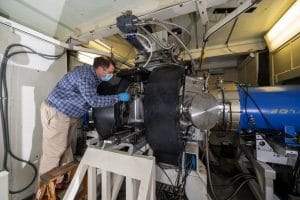Nuclear fusion has taken another important step forward in our advance toward a clean, renewable energy source. According to the publication New Atlas, “The US Naval Research Laboratory (NFL) is developing an Argon Fluoride (ArF) laser that may one day make fusion power a practical commercial technology.”
An argon laser is a device that uses argon gas and produces a very intense short-wavelength laser that can credibly scale to the energy and power required for high gain inertial fusion, sometimes called ignition. As reported in Newsweed, inertial fusion is the energy needed to both start and sustain a series of ongoing nuclear fusion reactions, which is the precursor to providing an inexpensive, safe form of electrical energy.
Lasers thus far have been limited in the robustness of creating this rection, but an ArF could be a game-changer. Steve Obenschain, Ph.D., a research physicist at NRL, states, “The NIF result is impressive and highlights the need to look ahead to what laser technologies will accelerate future progress. The NRL ArF laser technology provides a path to much higher fusion gain and yields,” thus overcoming inertial fusion issues that have plagued the advancement of nuclear fusion research.







